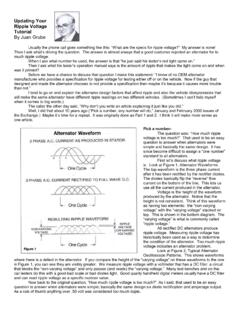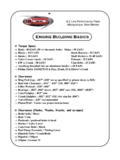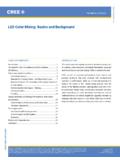Transcription of “How Generators & Regulators Work”
1 1 How Generators & Regulators work Once you understand the basics of how a battery works and how it is constructed,we can move on to the generator, which is the second most important parts of the sound bona fide, I might as well give you the official job description of the gen-erator. It is a machine that converts mechanical energy, supplied by the engine, intoelectrical energy used for either recharging the battery or supplying power to the electricalsystem. While the description seems a little confusing, if you follow along a little further wewill make sense out of it all. Come on, it ll be better than you work SCHEDULE FOR THE GENERATOR FAMILYWhen the engine speed is at idle or at low rpm, the generator has little or no output,and the battery provides all the electrical energy needed for the electrical vehicle speed reaches about 20 mph or engine rpm reaches about 1200, thegenerator will begin to charge.
2 The output will help the battery with some of the electricalload. (This speed is known as the generator cut-in speed.)At higher engine rpm of about 1800, the generator is capable of providing all of theelectrical current needed to run the accessories, as well as recharge the battery will usually provide their maximum output at about 1800 to 2300 rpmengine speed. Normally the pulley diameter of a generator is designed so the engine willspin the generator at, or close to, its ideal rpm, (the rpm at which the generator operatesmost efficiently.) This rpm is matched to the rpm at which the engine will spend most of MOST OLDER CAR APPLICATIONS, THE GENERATOR ARMATURETURNS ABOUT TWICE FOR EVERY RPM THE ENGINE a generator spins at high speeds (above 3500 rpm engine speed) the outputof the generator will actually drop off quite a bit, as the brushes are lifted off of the arma-ture by centrifugal force.
3 If heavier brush springs were used (a great idea), it would causeexcessive brush wear at the slow interesting note: Did you ever wonder why over the road trucks get such longlife out of their generator brushes as compared to a car? Here are the reasons. One is theconstant rpm that make it easy to match the correct engine to generator other factor is called air gap. This is when the brushes lift off of the commutatorjust slightly due to the centrifugal force. The brushes will then experience minimum wearbecause the brushes are not physically touching the commutator and the loss in output willbe driven in town will wear out generator brushes at a much faster rate than thosethat spend their life traveling up and down the highway.
4 The same principle WE ARE ON THE SUBJECT OF CARSOF THE LATE 1940 s AND EARLY 1950 s HAD AN INTERESTING SAFETY had what they called a brush protected generator. The field wire of thecharging system was routed through the ignition system. When the brushes in the genera-tor got too short from wear, the field wire would ground out the ignition and the carwould not this was a good idea in theory, it left a lot of early-day Buick owners strandedwithout warning (and very unhappy). The servicemen of the day carried a jumper wire inthe tow truck. If this was the problem (a simple check), they used the jumper wire to by-pass the generator to ignition circuit. If the car started, they simply drove it back to thedealership and installed new brushes in the generator.
5 And the customer was happily onhis , HOW COME THERE ARE SO MANY DIFFERENT SIZE PULLEYSUSED ON THE SAME STYLE OF GENERATOR?As we learned earlier, the pulley size is matched to the rpm at which the engine willspend most of its time running. In-town delivery trucks had a small diameter pulley so thearmature turned faster at the low engine rpm, increasing the output at the slow ELECTRICITYAll Generators make electricity in much the same way. Let s take a look and seewhat parts make up a generator and what job each of those parts has to perform. As Ihave done before, I will give you the official description of what a generator does, thenexplain things in common operation is based on the principle of electromagnetic induction.
6 Thismeans that voltage is generated when any conductor is moved at right angles through amagnetic field. When voltage is produced in this manner, it will cause the current to flow inthe conductor if that conductor is a complete circuit. Whew! Got all that? Now let s ex-plain that in common sense terms, starting with the internal - An armature starts out as a bare hardened steel shaft. To this shaft isadded a series or group of non-insulated copper wires wound close together. They in turnwill form what is called a loops of wire are then embedded in a series of slots in an iron core. This iron core is3then attached to the armature shaft. This shaft spins and helps to generate the electricalcurrent.
7 As you might guess, the size of the wire and the number of wires in the loop willaffect the output of the - The commutator is aseries of segments or bars that are alsoattached to the armature shaft at the rear ofthe armature. It is the wire ends from theloops of the armature windings in the iron corethat are attached to the commutator. Whenthis is done, a complete circuit is COILS - Field coils are thewindings or the group of wires that arewrapped around the pole magnet. It is the jobof the field coils to take the current drawn tothe pole magnet, and make it stronger. (Fieldcoils are the windings that are attached to theinside of the generator housing.) This in-creased strength in current will force evenmore current to be drawn to the pole magnets,which will continue to build up is how the current produced by thegenerator is built up and increased, until it canbe used by the battery and the ends of the armature loop are securely attached to asplit ring called a - After the generator develops the current, it is the brushes that carry the cur-rent to the field circuit and the load circuit, so the electricity can be used by the batteryand the accessories.
8 This process is called commutation. The brushes will ride on thecommutator segments of the armature. Brushholders hold the brushes in position by way ofspring automotive Generators will containtwo brushes, one that is grounded to the frameof the generator, one that will be insulated fromthe insulated brush is the positivebrush and is connected to the A terminal ofthe generator, and to one end of the field other end of the field coil is connected tothe insulated F terminal of the AND BUSHINGS - At either end of a generator you will find a bushingor a bearing. They have the job of making the armature shaft run true in the housingbetween the field coils and pole will be made of copper or brass and are soaked in oil before they areinstalled.
9 The brass or copper bushing material is porous and able to absorb the oil like a4sponge. This provides the lubrication between the shaft and the bushing. They can alsobe re-oiled from the oiling tube on the outside of the heavy-duty Generators will use ball bearings instead of bushings for thearmature shaft to ride . This is done to support a radiator fan or other A WORKING GENERATORAn assembled generator will look some-thing like this: The electrical rule that ap-plies to a generator states that electricalvoltage will be generated when any conduc-tor is moved at right angles through a mag-netic field. To demonstrate this theory to yourself takea simple horseshoe magnet and stand it onits side.
10 (It will have a north pole and asouth pole, just like in your generator.)Now take a piece of plain copper wire andmove it back and forth between the poles ofthe magnet. You will be breaking the mag-netic field, which will produce a magneticcurrent inside of your wire. This is exactlywhat the armature does to the field current is produced this way, it will cause current to flow in the conductor if itis a complete circuit. (Remember the armature with the loops of wire embedded in theslots of an iron core? Didn t the ends go down and connect to the commutator to form acomplete circuit?) Okay, so you re let s look at a simple generator with an armature that has only one turn or loopof wire and two pole pieces.










